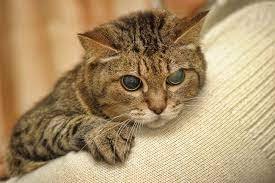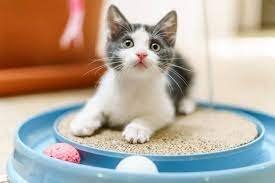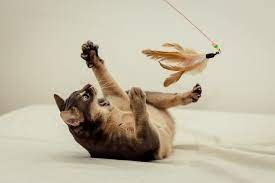
Blog
Asking For A Fur-Friend
Enrichment for Blind Cats: Purring in the Dark
Today we're going to embark on a special journey to explore the wonderful world of enrichment for our beloved blind feline companions. Cats may be known for their keen senses, but did you know that blind kitties can lead incredibly fulfilling lives with just a few adjustments? Let's dive into the pawsitively exciting realm of enrichment for our visually impaired feline friends!
Today we're going to embark on a special journey to explore the wonderful world of enrichment for our beloved blind feline companions. Cats may be known for their keen senses, but did you know that blind kitties can lead incredibly fulfilling lives with just a few adjustments? Let's dive into the pawsitively exciting realm of enrichment for our visually impaired feline friends!
Embrace the Sensory Symphony
For our blind whiskered buddies, the world is a symphony of scents, sounds, and textures. To create a sensory wonderland, consider introducing scented toys, textured blankets, and toys that make noise. Think crinkles, bells, and even toys that emit gentle vibrations. This multisensory approach will engage your blind kitty's other heightened senses and make every playtime an adventure.
Auditory Amusements
Cats are natural hunters, and blind kitties are no exception. Enhance their playtime by incorporating toys that produce sound. Toys with jingling bells, chirping birds, or rustling fabric can turn an ordinary play session into a thrilling auditory experience. Be sure to supervise your blind feline during play and encourage them to follow the sound, stimulating their hunting instincts.
Safe Havens and Vertical Escapades
Creating a safe environment for our visually impaired feline friends is crucial. Designate specific areas in your home as safe havens, equipped with cozy beds, scratching posts, and, most importantly, familiar scents. Cats love to explore vertical spaces, so invest in cat trees or shelves that allow your blind cat to climb and survey their kingdom safely. This not only enriches their environment but also provides an elevated sense of security.
Tantalizing Tastes
Blind cats may rely more on their sense of taste and smell. Entice their taste buds with a variety of treats and food puzzles. Puzzle feeders can be filled with your cat's favorite kibble, encouraging them to use their paws and nose to uncover the tasty treasures within. This not only provides mental stimulation but also turns mealtime into a delightful challenge.
Touch and Bond
Blind cats thrive on physical contact and reassurance. Regular grooming sessions can be a bonding experience, creating a strong connection between you and your feline friend. Use a gentle brush to stimulate their skin and provide a comforting touch. This not only keeps their fur in top condition but also fosters trust and emotional well-being.
Tailored Toys for Tactile Triumphs
Opt for toys with different textures to engage your blind cat's sense of touch. Soft plush toys, crinkly materials, and toys with varied surfaces will keep them intrigued. Additionally, interactive toys that dispense treats or have hidden compartments add an extra layer of excitement, promoting both mental and physical stimulation.
The Power of Routine
Blind cats often thrive on routine and familiarity. Establish a consistent daily schedule for feeding, playtime, and rest. This predictability provides a sense of security for your blind kitty, allowing them to navigate their surroundings with confidence.
In conclusion, our visually impaired feline friends are not limited by their lack of sight. With a little creativity and a lot of love, we can create an enriching environment that caters to their unique needs. So, whether you're a seasoned cat enthusiast or a new fur parent, let's join paws in making the world a brighter place for our blind kitties!
If you are in the Naperville, Elmhurst, Villa Park or Lombard, IL communities and have a vision impaired kitty, consider contacting us for pet sitting services. Call or reach out to us here.
Purr-fect Enrichment: A Guide to Spoiling Your Senior Kitty
Today we're diving into the wonderful world of feline enrichment, with a special focus on our wise and whiskered senior companions. Our senior cats have given us years of love, purrs, and countless moments of joy. Now, it's our turn to give them the best in return!
Today we're diving into the wonderful world of feline enrichment, with a special focus on our wise and whiskered senior companions. Our senior cats have given us years of love, purrs, and countless moments of joy. Now, it's our turn to give them the best in return!
The Golden Years of Kittyhood
Just like us, our feline friends experience changes as they gracefully age. But fear not, for the golden years of kittyhood can be just as joyful and fulfilling! To make these years truly special for your senior cat, let's explore some enchanting ways to enrich their lives.
Cat Castle: A Palace Fit for Royalty
Every feline deserves a castle, and our seniors are no exception. Create a cozy and regal sanctuary for your cat with plush beds, soft blankets, and a variety of textures. Senior cats often appreciate warm and comfortable spots where they can snooze the day away, so don't be shy about pampering them with the finest feline furnishings.
Fishing for Fun: Interactive Playtime
Engage your senior cat's playful spirit with interactive toys. Wand toys with feathers, strings, or crinkly materials are purr-fect for light play sessions. Encourage gentle exercise to keep those joints nimble and that heart healthy. And don't forget to shower them with praise for every pounce!
Garden of Delights: Indoor Greenery
Bring the outdoors in by creating a little garden haven for your senior cat. Cat-friendly plants like catnip, cat grass, and spider plants provide a touch of nature and stimulate your cat's senses. Just make sure the plants are safe for feline friends, as some can be toxic. A vet consultation can help you select the safest options for your senior.
Culinary Concoctions: Gourmet Dining
Spoil your senior cat's taste buds with a culinary adventure. Consider trying a variety of wet and dry foods to keep mealtime exciting. Specialized senior cat diets are designed to support their changing nutritional needs. And, of course, don't forget to include treats – because every cat deserves a little indulgence!
Birdwatching Bliss: Window Perches
Give your senior cat a front-row seat to the captivating world outside with a comfortable window perch. Watching birds, butterflies, and passing clouds can provide endless entertainment. It's a low-effort, high-enjoyment activity that keeps your senior cat mentally stimulated and content.
Spa Day Extravaganza: Grooming Galore
Senior cats may appreciate a bit of pampering, and what better way to spoil them than with a spa day? Gentle brushing helps keep their fur sleek and reduces the risk of hairballs. Plus, it's a delightful bonding experience that reinforces the love between you and your fur baby.
Love and Attention: The Ultimate Enrichment
Above all, the most valuable enrichment you can offer your senior cat is your love and attention. Spend quality time together, offer gentle pets, and engage in quiet conversations. Your presence and affection are the true treasures that make your senior cat's golden years truly magical.
So there you have it, a guide to purr-fectly spoiling your senior kitty! I hope these enchanting ideas bring joy and fulfillment to the golden years of your feline companion. After all, our senior cats deserve nothing but the best – because they've given us their best every day.
If you have a senior cat and are looking for a pet sitter in the Naperville, Elmhurst, Villa Park or Lombard communities, give us a call or contact us here.
How Much Exercise Does Your Cat Need?
We know that exercise is crucial for our feline friends to keep them healthy and ensure good muscle and bone health. It can also help with your cat's coordination when they stalk, chase and attack their prey.
We know that exercise is crucial for our feline friends to keep them healthy and ensure good muscle and bone health. It can also help with your cat's coordination when they stalk, chase and attack their prey. Obesity in cats is a problem and engaging in play every day with your cat can help reduce their risk for being overweight. Another reason we need to make sure our cats are getting adequate physical play is that it leads to mental stimulation. Exercise helps avoid depression in humans, as well as in our pets, and studies show about 40% of cats suffer from this due to boredom. We know pets who do not have enough physical and mental stimulation can develop behavioral problems, which can be destructive, such as scratching furniture, chewing or being overly hyperactive.
On average, cats need about 30 minutes of physical activity every day. The amount of exercise required might also change depending on your cat’s age and whether they are indoor-only cats. Naturally, cats are hunters and respond to stimuli quickly. If you have an indoor/outdoor cat, while I do not agree with it, those cats who go outdoors require a different exercise regime than indoor cats do. Cats who venture outdoors have unlimited space to roam, they are more physically active and tend to get enough exercise naturally. Also being outdoors those cats are exposed to stimuli such as bugs and leaves which motivates them to perform stunts and be more active. Indoor cats have limited space and less exposure to natural stimuli unless they are like my cat, Phoebe, who finds spiders in the basement we didn't even know were down there. We need to make sure we are motivating our cats to participate in interactive games. You can do this by using toys like feathers, ropes and balls to keep them healthy. Engaging in play with your cat helps enforce the bond you have with your pet as well.
Whether your cat is older or is a young kitten also determines how much play they should have each day. Adult cats should exercise daily for at least a half an hour to keep their body fit and healthy. It also helps to keep their hunting skills sharp and provides the mental stimulation they need. On the flip side, kittens and young cats can sleep up to 22 hours a day, so they are naturally not as active as adult cats. Even though they are not as active, you should still exercise them daily with their favorite toys.
Fun and Easy Exercises for Indoor Cats
Bathtub Ball. With a dry bathtub, toss a ball inside. Your feline friend will be able to play freely inside the tub. Cats do not get bored easily when there are moving targets involved, so let them bat the ball around; you can join in and roll it for them to chase.
Laser Pointers. As we mentioned, cats love things in motion. You can use a laser pointer to keep your cat moving. To encourage your cat to play, use the laser pointer to move like a mouse or bug may move. Always remember to reward your cat after playing with the laser pointer, as there is not a tangible item they are catching; a treat can make up for it.
Animal Toys. Cats are very observant creatures and can somehow distinguish the physical appearance of real life and fake stimuli. Consider getting your cats toys that resemble real animals like birds, bugs and mice. To make it more exciting, connect a string to the toys and give the toys some life.
Ribbons and Wands. Tie a ribbon or string to the end of a wand and let your cats chase it around the house. These toys are great while you are engaged in play with your cat, but should be put away when the cat is alone to ensure they do not accidently choke on it.
Food Exercise. Mealtimes are very exciting and tempting for cats, especially when wet food is involved. We can help our cats hone their hunting skills by changing up the places where we feed them, or place the wet food in places they may need to climb or hunt for it.
Get Some Cat Towers. Cats love to climb and jump on things, so encourage them to use a cat tree instead of a couch or chair. Multi-tiered cat towers ensure your pet has lots of places to climb and play. To encourage your cat to climb or jump on their tree, place some treats on different levels to help them explore.
Try Catnip. Catnip and catnip toys are useful to help your cat to exercise. Your cat can have fun eating, rolling and being stimulated by the nip, but please note that some cats do not respond to catnip and some may become overly stimulated by it.
Introduce Leash-Walking. Much like training dogs on a leash, you can entice your cat to walk on a leash and harness outdoors. This can be a safe way to introduce your cat to the outside world. It is best to start young and slowly introduce the harness to your cat. Always make sure the harness is secure so your cat cannot wiggle out of it.
Get Your Cat A Pinata. Cats love batting at hanging objects. Putting kibble or treats in the pinata can motivate your cat to bat and play with the pinata. Your cat will be rewarded for their work as the treats drop from the pinata as your cat plays.
Match Exercise Partners. Unlike dogs, your cat may not respond to your requests to play or engage. You can consider adding a second cat as a playmate. They can get along well and engage each other in fun activities like chasing each other, wrestling or even cuddling.
So, overall, most indoor cats do not receive enough playtime and as pet owners, we should take the time to engage with our pets and ensure they get the physical activity they need. Choose games your cat enjoys or get to know which toys are their favorite. Even if 30 minutes does not fit into your schedule, any amount of vigorous play is great for our cats.
Enriching Your Cat’s Lives
We are always looking for different ways to connect and socialize with your feline friends. Some are more social and comfortable with us than others, but we can add enrichment to all cat’s who we cross paths with.
As a pet sitter, we are always looking for different ways to connect and socialize with your feline friends. Some are more social and comfortable with us than others, but we can add enrichment to all cat’s who we cross paths with.
So the first thing we need to know is that cats are always in fight or flight mode. They are one of the only mammals who are both prey and predator. They hunt for their food but are also prey for many other animals. This is also why it is a good idea to always keep your cat indoors. With this knowledge we can begin to recognize what our feline friends are going through. They are constantly trying to decide whether every person, noise or object is a threat or not and can be the reason why it can sometimes take some time for a kitty to warm up to you. They have to decide you are trustworthy and some cats take longer to make that decision.
When we talk about our cat’s health we usually are speaking to their physical health and well being, but we also need to make sure we are taking care of their emotional and cognitive health as well. So most cat’s lifestyles may look like hunt/play, eat, sleep, groom and be social. Most cats perform this cycle more than once per day and we want to make sure our cats are making the most of each activity.
I know I mentioned hunt earlier, but for cats that is their mode of play. So when you are engaging with your cat in play it should always mimic hunting. The stages of the hunt are eye, stalk, chase, pounce and kill. So think about what toys your cat loves playing with the most. It is a string with a toy on the end or maybe it’s a laser pointer or even a toy mouse. Each of those things mimics the hunt. Your cat sees the toy, red dot or mouse. They then will stalk it, some cats get down low and with quick head movements follow the item and prepare for the next step. Chasing - most cats will love to chase a toy mouse that has been thrown or will chase the red dot of a laser around a room and up the walls and even chase that toy on the string whether in the air or on the ground. Always remember, as your cat ages, they will still want to engage in the hunt play but you may need to slow things down or move to them casing objects on the floor and not in the air. The next stage is the pounce, we may see this occurring when our cats start to dance with their rumps in the air and boom, there they go! And finally the kill. While we don’t love it when our cats bring us a gift of their kill, we always need to make sure the play ends in a reward. Allow your cat to catch the toy at the end of the string, make sure they catch the dot and allow them to catch the mouse toy and bring it to you as a gift. Now when it comes to catching the red dot, that on its own is not always fulfilling, what I do with Regina and Phoebe I position the laser to one side of the room, drop a few treats on the floor and bring the laser back to the treats, it is their reward for ‘catching the red dot’. Always remember to rotate your cat’s toys every few days or weeks, just as we can get bored of certain items, cats do as well.
Eat. First I want to pose the question to you, where do you feed your cats? Most people say kitchen, why? Well most likely we feed our cats and dogs for that matter in the kitchen because that is where we eat. But, what if your feline friends don’t want to eat in the kitchen or even the same spot each day? They most likely will never be able to tell us where they would prefer to eat, but there are some basic things about cats we should know and this can help your cat feel more fulfilled during feeding times. While the quality of food we feed our cats is very important, we also need to keep in the back of our minds that sometimes where we feed our cats is more important than what. Cats, as creatures, want to work for their food. It is a basic instinct for them. Puzzle feeders can be great for this, there are so many styles of feeders from timers to puzzles. Just adding a puzzle feeder into your cat’s routine can create enrichment that has been missing from their lives.
Sleep. Did you know that cats spend between 12 and 16 hours each day sleeping, which means they sleep for 50-60% of each day. This is the time your cat recharges, since they are constantly in fight or flight mode, it takes a lot of mental energy for them to make it through the day. While your cat may spend most of their time sleeping, we need to make sure we are recognizing sleeping vs. being lethargic. It is always good to know your cat’s routine, as becoming lethargic can be a sign of something being wrong. Remember since they are also prey animals, they will try to hide illness and injury from us.
Groom. Cat’s love to groom themselves and if you have more than one cat, you may notice they groom each other. Welcome, hairballs! There are many reasons why our cats groom themselves. After your cat eats, you may notice they tend to immediately start grooming, they are hiding the scent of their food as well as their scent. When you cat groom themselves or another cat they are cleaning their fur of any debris or other scents as well as dispersing oils from their skin and fur evenly throughout. You always notice when a get is either no longer able to groom themselves as their fur becomes matted and oily in spots. Cats also groom themselves to clean injuries. Did you know that cat’s saliva has some antibacterial matter in them. Not saying if you are cut, you should allow your cat to clean your wound, but they will lick injuries as a way to assist with the healing process. And most fascinating, did you know that when a cat grooms they are also regulating their body temperature? After a cat is done grooming, touch the spot they just cleaned and it is actually cooler than other parts of their bodies.
And Social. Make sure when being social with your cat you are engaging in all five senses. This can be talking to your cat while they are on your lap and you are petting them. Trust is always key when interacting with a cat. In our business we do sometimes encounter cats who are shy or fearful, even just sitting in the same room with the cat, as long as they have a way out, can be enough social interaction.











